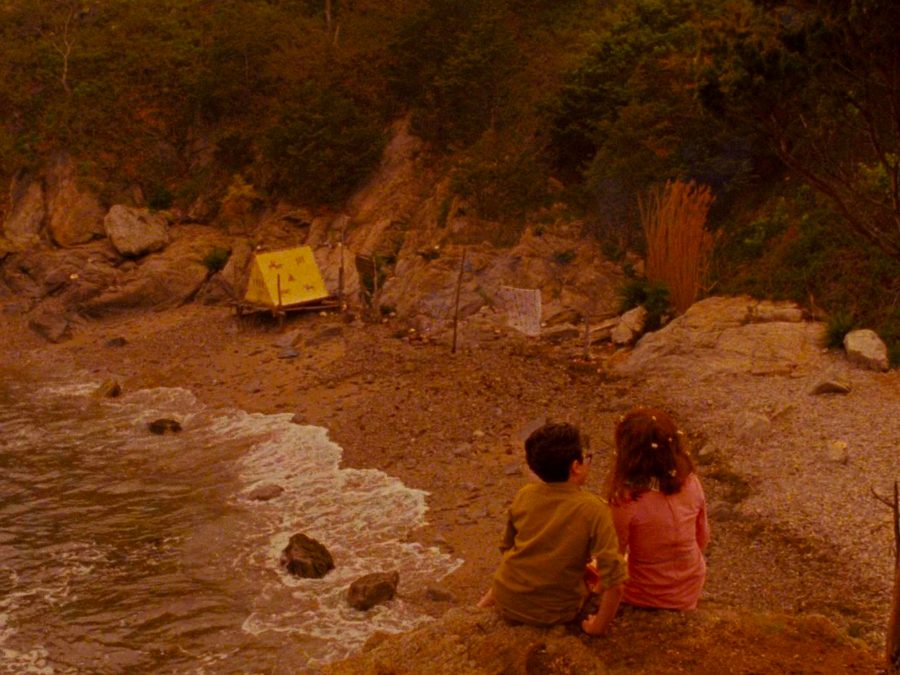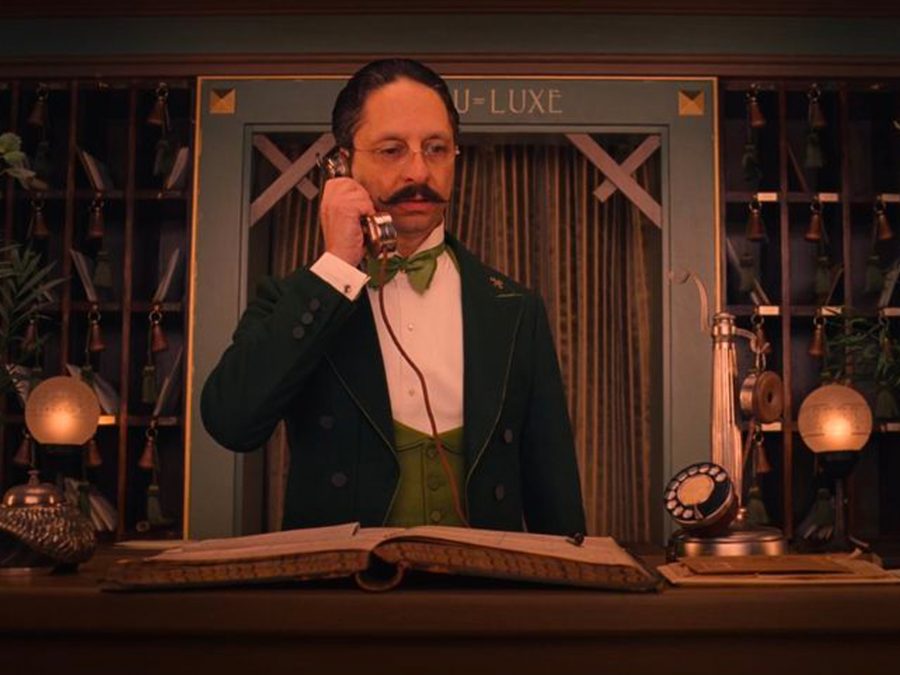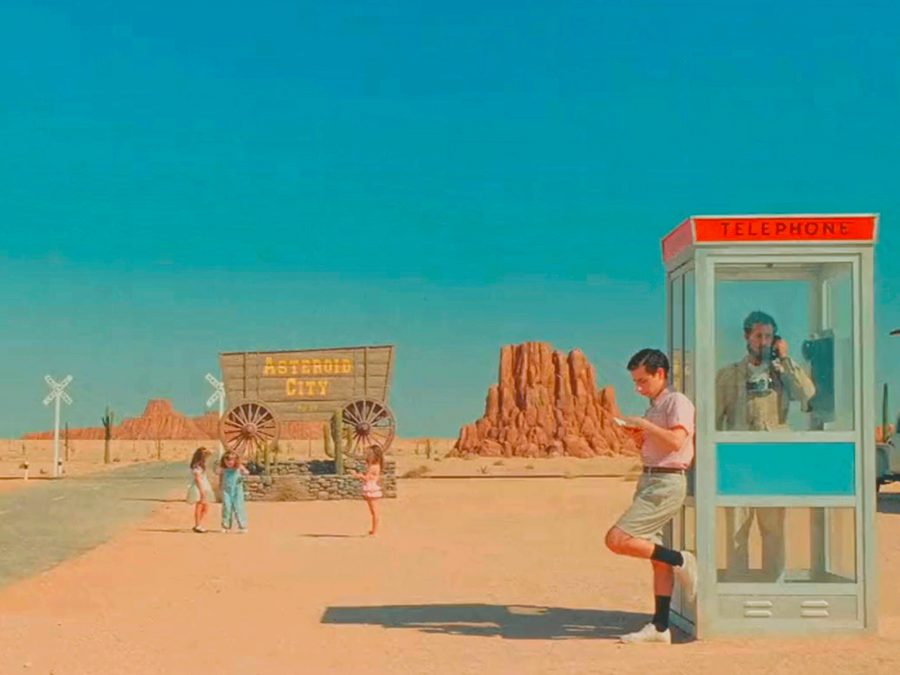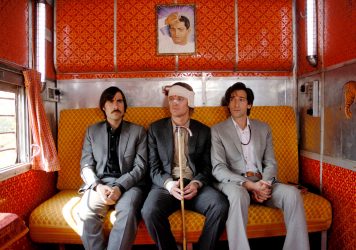
Through conversations with psychologists, neurodivergent friends, Jason Schwartzman and the man himself, Sophie Monks Kaufman investigates the meticulous worlds of Wes Anderson and their potent emotional frequencies.
The most remarkable thing about Richie Tenenbaum’s suicide attempt in Wes Anderson’s The Royal Tenenbaums is that it moves to the rhythms of entertainment and is all the more devastating for it. The set-up foregrounds Raleigh St. Clair foetal on the sofa, having just found out that his wife has cheated on him many times. His experimental subject, Dudley, tries to uplift him with a word game, which in itself is moving as Dudley is usually found passively vibing. Only in the background does Richie slip into the bathroom to shave his beard and cut his wrists.
Over the next 90 seconds, through the use of music, beat-matched editing, montage, homage to French cinema, character acting from an ensemble cast and Anderson’s signature tragicomedy, the screen is flooded with two extraordinary waves of feeling. The first is the loneliness of someone who has decided he does not belong to this world. The second arrives at the speed of family, friends and stalwart Dudley hot-tailing it to be with him in hospital: not only does Richie belong to this world, he belongs to a tribe that accepts him at his lowest.
There are countless reasons why a person can feel incoherent in the course of normal life, and the extent to which it is helpful to pathologise this is a matter for each individual to decide. Yet, as someone diagnosed last September – as an adult in my 30s – with both ADHD and autism, I find ‘neurodivergence’ to be a revelatory label for now. Even so, I hope to eventually find a more inclusive expression of my existential struggles. For, as Charles Bramesco [friend, LWL contributor, man about town] recently wrote in his Asteroid City review, “We’re all contending with interior dramas about which everyone else knows nothing.”
To avoid making general claims about an experience that is infinitely diverse in its presentation, this piece will cleave to my own trials; however, I know that I am not alone as a neurodiverse person in feeling both represented and soothed by Anderson’s cinema. Weighing in with her own experiences will be Lillian Crawford, whose amazing Moonrise Kingdom episode of the Autism Through Cinema podcast sits sweetly in the centre of a career that includes both cultural criticism and improving access to cinema. This latter project currently takes the form of relaxed screenings at the BFI and The Garden Cinema. She writes a complementary column that illuminates the sensory experience of being a neurodivergent audience member.

The term ‘neurodiversity’ (ND) was coined in the 1990s by Australian sociologist, Judy Singer, as a celebratory alternative to clinical diagnoses like ‘autism’ and ‘Asperger’s Syndrome’ which often came with the tag that a person was abnormal and needed to be fixed. She argued that “Neurodiversity may be every bit as crucial for the human race as biodiversity is for life in general.” These words were published in The Atlantic in 1998, where she added, “Who can say what form of wiring will prove best at any given moment?”
Her challenge has grown into the Social Model of Disability, which tells us that a person is not necessarily disabled by their health conditions, but by society’s failure to adequately accommodate their needs. Whether ND conditions are best framed as differences or disabilities is a hotly contested subject that I wish to swerve in the name of trying to clarify aspects of my ND experience through the characters that Anderson tends to portray. Simultaneously, the heightened production design is an entry point to the fact that environmental organisation plays a huge role in determining ND quality of life. Indeed, Anderson’s devotion to form offers almost a platonic ideal in terms of a familiar, colour-coded and signposted universe where chaos is tamed (at least visually speaking) and emotionally messy characters are dignified by a pristine aesthetic.
Out of a perceived or real pressure to blend in, neurodivergents tend to have social anxiety and believe that we need to mask both that social anxiety and our true selves in order to be accepted. “This is particularly the case for neurodivergents who have not been diagnosed until later in life who have accumulated a lot of coping strategies as a result of pretending to be something that we’re not. These coping strategies are workarounds we have found to get the job done or coexist amongst neurotypicals,” says Samantha Hiew, a Renaissance woman with a dizzying range of qualifications. She has a PhD from UCL in Cancer Virology and Childhood Leukaemia, and has worked as a model, presenter, and communications lead. Following a diagnosis of ADHD at the age of 40 Hiew founded ADHD Girls, a social impact company with a dual mission to “empower girls and women with ADHD to thrive in society” and “improve neurodiversity understanding via intersectional lens”. To that end she works as an Intersectionality & Neurodiversity Professional Speaker and Consultant, speaking at events and going into workplaces with the purpose of empowering the neurodiverse and educating the neurotypical.
Hiew explains that masking manifests in different ways for different people, however a common one for ADHDrs is, in an effort not to blurt out interrupting thoughts, we repress and forget them, ending up silenced and drained by trying to spot the right cue. Whereas autists who would instinctively self-soothe through stimming (repetitive movement and/or sounds) may exhaust themselves by trying to squash this impulse or find the most socially palatable version of it (like playing with their hair). Longterm, it’s a losing game to find acceptance by routinely betraying ourselves. Hiew says that ND people often swing between extremes and some try to cope with their innate difference by pursuing a perfectionist personality. This resonates deeply as someone who lost years to an obsessive pursuit of the so-called “perfect body”, a doomed goal onto which I projected nothing less than transcendence from all my problems.
There is a dialectical breadth to Anderson’s cinema in which things do indeed look perfect, but it isn’t the vacant sheen of a car commercial or the misleading glamour of an anorexic model, it is more like the polished glass cases within an exhibition curated to let a cornucopia of curios shine. There is a satisfying conflict that I experience watching films which combine the hopelessly aspirational (aesthetics and wit) with raw profundity (insoluble emotional problems). There is no simple or straightforward way to parse his work, just as there is no simple or straightforward way for an ND person to move through the world. As Hiew says, “The harder we try to fit into society, the more we feel like we don’t belong, and the more it causes complications inside our minds: anxiety, depression, or feeling dysregulated because we aren’t accepted even in our closest sphere.”

Masking is not a thing in the Anderson-verse. Time and again, he finds humour in the kind of anarchic emotions that would have an ND person melting down, before finding a place for them within an ordered, quick-marching scene. Characters may be deadpan and restrained, but they do not plaster on a smile and say, “Fine, thanks!” when they are not fine, thanks. “Of course it was dark, it was a suicide note,” Richie responds to friend-and-love-rival, Eli Cash, after waking up in the hospital. Dialogue is written along a spine of abrasive integrity, with even peripheral characters seeming to emerge from a shroud of personal depths.
In The Grand Budapest Hotel, a role-call of Anderson collaborators show up for barely a minute of screen time to play a retinue of moustachio’d hotel concierges aka The Society of the Crossed Keys. After freshly-sprung jailbird Monsieur Gustave H puts in an emergency call for their mysterious powers, one by one they perform riffs on the same ritual: take the SOS call; hand over a task to their lobby boy; lobby boy steps in for anything from flavouring the soup to administering CPR; call the next moustachio’d hotel concierge. Bar Bill Murray who appears briefly once more, none of these actors are seen again, having fleetingly had fun with their personalised take on a secretive and exacting man.
“If you are in an environment that supports you to be yourself, and you have the privilege to unmask, then it is a good way to heal,” says Hiew. Unmasking is something that can happen alone in the dark of a movie theatre and I now understand why the onscreen evocation of raw-yet-precise emotional frequencies causes a dopamine surge in my body. “We’re all looking for that thing that helps us get over our past,” Hiew explains further. “In order to do that, we need to understand what makes us unique. Unmasking and being authentic helps us get there.” Wes Anderson’s cinema is too vast to be reduced in any one way, but it is an arena where having inappropriate feelings is the norm. We can let down our censors and laugh at absurd sources of suffering and the trying task of staying connected to our nearest and dearest – a pursuit that, perhaps, motivates Anderson’s filmmaking in the first place.
“The short answer is yes, I think,” he says, when I put the question to the filmmaker. “Well, it is part of a motivating factor. Most of my time I spend with my wife and daughter, we have lots of fun together and we go places together, but my movie life is a separate thing and a second family, in a way. Often with some of the cast members in the movies, I don’t see or rarely see them except for when we work together. Then, when we’re working, we see each other every day. Every day at dinner, whether people were working or not, they’re all talking about the thing we’re doing together. It kind of binds us.”

I ask if there’s a unifying principle that binds his collaborators, beyond talent, as he often works with the same cast and crew over many years or even decades. “Unifying principle, I don’t see one. I think there’s no principle. It’s the people who’ve chosen to want to stay with me and who I’ve had good experiences with. Their personalities can be so sharply different.” He gives a bottled sense of his varied collaborators. “Milena Canonero has a group that moves with her from place to place. And the group is very focused on her and she’s Italian and has a funny and wild way of communicating. Adam Stockhausen has a vast team, but he works with a quiet, precise method. Bob Yeoman is always very funny.”
“Maybe there’s something in that about creating a world, or a family, and the familiarity of, ‘Oh, this person is here and they’ll do this thing that we’re used to them doing,’” says Ben Adler, an associate producer on Wes Anderson’s films. “Jarvis [Cocker] will be somewhere doing a song, and singing it in the movie and recording it, and then he’ll play it in front of people as a concert. In the same way that families and groups have their traditions, I think that’s important to Wes, and makes it extremely special for all the people involved.”
Londoner Ben moved to Paris from the UK to study film in 2006 and was first hired by Anderson in 2009 after responding to a mysterious Craigslist post stating that an international director was looking for an intern. Ben worked as an assistant on Fantastic Mr. Fox and The Grand Budapest Hotel before becoming an associate producer on Isle of Dogs, The French Dispatch and Asteroid City. He is often involved in something he believes is crucial to a Wes Anderson production: pastoral care. A collective spirit is fostered as the cast and crew live together during the shoot: “There are no trailers, there are no five-star hotels, you’re not getting room service and there might not even be a minibar in the hotel rooms but everybody’s eating breakfast and dinner together, before and after the shoot. It really fosters an environment more like a theatre troupe or a summer camp – a family, really. I think Wes knows that everybody making the film will have a greater experience if it’s like that and, in some way, maybe that feeling does make it onto the screen.”
On top of this, there are often special touches and activities off-camera that would slot right into the movies themselves. To wit: the actors in The French Dispatch were gifted a pair of locally made slippers (“Charentaises” – a speciality of the Charente region where the film was made) which became the unofficial uniform of downtime. The existence of the Asteroid City production village in Chinchón, Central Spain gave rise to a tennis tournament, Bob Yeoman’s movie nights, all washed down with Bryan Cranston’s tequila. Meanwhile, the chef of the local hotel made mealtimes a curated voyage around the regions of Spain. “I have a burgeoning obsession with the numerous varieties of gazpacho thanks to that experience,” says Adler, adding, “The kind of people that are coming on this adventure with Wes are generally up for a side project. Fun and unexpected things tend to develop and happen almost constantly.”
The view from the other side seems to chime with Adler’s description of a wholesome, familial, protective and – first-and-foremost – creative environment. Actor Jason Schwartzman confirms that this has been the case as far back as Rushmore, Anderson’s second feature. Schwartzman, aged 17, became the precocious and imaginative schoolboy, Max Fischer, and a friendship hit the ground running. “Wes and I were in this hotel and we would have dinner almost every night together in his room. We would talk about movies, the next day’s plans and what we were thinking about,” recalls Schwartzman, tracing a line between what moved him then and still does now. “It’s this continuation of life and work that I remember was so important to me. It’s still the same thing. It’s just that the dinner table is bigger.”
One major thing that can make an ND person feel safe to unmask is the feeling that the other has, in their own way, done the same. Authenticity calls out to authenticity. When Schwartzman talks about Anderson inviting collaborators, not just into his process but into his personal space, it resonates as a collective intimacy that makes its way onto the screen. Although there is a uniform mode across any given ensemble, each actor makes a strong personal impression and feels very much like themselves, even as they expend great effort to hit specific marks and deliver dialogue at pace. If Jean Luc Godard was right when he said that every fiction film is a documentary of its actors, Wes Anderson makes documentaries about actors showing something real to each other and supporting each other to do this exposing work.
Per Schwartzman: “It’s so wonderful because you realise how much people want to be together and talk to each other and how unique it is. The work is hard and there’s a camaraderie every night afterwards.” At the centre of this camaraderie is the head of the sports team, scoutmaster Anderson. The care that flows to and from him is especially crucial for Schwartzman who counts Anderson as one of his closest relationships outside of his blood family. Their 25-year friendship is threaded around their storytelling adventures. “Our whole relationship has always been so encouraging in terms of going off and finding new interests. Wes is endlessly curious and always searching for new things. Our relationship has a lot of that so it’s a building up of a store of positive scar tissue,” He corrects himself, “ – all scar tissue is positive, I guess.”
This nurturing interpersonal dynamic is the expression of an ideal, as, for ND people to thrive, we need loving encouragement and even cheerleaders who see us unmasked and still believe in us more than we believe in ourselves. It has a growth effect on Jason’s faith in his acting range, too. “When I read the part in Asteroid City, I remember thinking, ‘Wow, this is farther than me. I don’t think I can do this.’ But Wes was like, ‘No, no, no, you gotta grow.’ Going into this territory that was unknown for the both of us was really scary and fun. There’s no one that I’d rather do that kind of thing with than him. We love each other. He’s pushing me to go to places that I haven’t been before while knowing where I’ve been.”

Alexithymia means “having no words for a feeling or thought” – to elaborate: “The cognitive inability to encode, identify, and describe one’s own and another person’s emotions.” [source]. Ironically, when the doctor dropped that term in the middle of my assessment, he gave me a word that sped backwards across memories of relationship frustrations. I realised that I have a strong affinity for emotionally legible artforms because when I see certain feelings portrayed I gain the ability to identify them in myself, like a monkey recognising itself in the mirror for the first time. Wes Anderson characters, by and large, sit on an iceberg of emotion that colours their presence without them ever owning it, per se. As Schwartzman puts it, “I feel like they’re quite emotional, the movies, in the way that it is when you’re sitting next to someone and you know that they’ve got something inside. But they’re not talking about it and you’re like, ‘Gosh, I can feel this. But we’re not talking about it.’”
“It was entirely about emotions,” says Anderson about Asteroid City. “The form is a kind of concoction. We want to entertain the audience. But the way we wanted to do it with that one was… We thought we were creating some kind of poem that even we didn’t fully understand.”
At the outset of Asteroid City, Augie (Schwartzman) has yet to tell his four children that their mother died three weeks ago. They have arrived at their desert town destination, monogrammed luggage lashed to a clapped-out car, for the Junior Stargazers Convention, to which inventor Woodrow (nicknamed ‘Brainiac’ by his deceased mother) has been invited to compete for a cash prize. Although the time is never right to break news of this nature, Augie sits Woodrow and his triplet kid sisters – Pandora, Cassiopeia, and Andromeda – down to finally level with them.

The death is announced with a brisk and respectful transparency usually observed between colleagues of many years, rather than a 40-something man and his children. “It was intense,” says Schwartzman, “because, I was like, ‘I don’t know what they know or don’t know or believe or don’t believe about really everything – specifically something like death.” He cautions them against believing platitudes (time doesn’t heal all wounds, at best it’s a band-aid) while conceding there is a limit to how much he can explain about this loss when the girls have no concept of time. Their reaction is vague, as none of them – not least Augie – can grasp the significance of this absence. (Who amongst us could?)
The accepted conventional version of this scene would have someone falling to their knees and screaming at the heavens, but there is authenticity to the mannered quietness here. “It’s how I have emotional conversations, I don’t get hysterical,” says Lillian Crawford. “I find it so much more moving to see someone fighting to be articulate. Being autistic, for me, means that I often have 1000 things swimming around in my head, I have a million connections being made all at once. And I’m trying to grasp at it, and place it, and connect it, and tie it down in a way that someone else might understand, trying to remember that other people aren’t in my head.”
Samantha Hiew thinks that alexithymia (and a variant ‘dyslexithymia’, meaning “the wrong words for feelings”) may be the neurodivergent quality that has the biggest impact on intimate relationships: “You can often feel like you’re stuck in a mental prison where you really want to reach out but you can’t do it in the right way. You might get misunderstood. And maybe it’s a delay in processing thoughts as well. It might not be that you cannot feel, it might be that there’s a delay in feeling. Something else down the road might trigger a particular memory that will then make you feel something that you forgot to feel a few weeks before.”
Published 26 Sep 2023

The maestro behind Asteroid City leaves a voice note for LWLies, reflecting on naming conventions, sci-fi films, and working with his best friends.

Sophie Monks Kaufman continues her deep dive into the neurodivergent coding of Wes Anderson's cinema in this far-reaching long read.

The Whitmans, the Tenenbaums and others lifted my spirits at a time when it seemed nothing could.